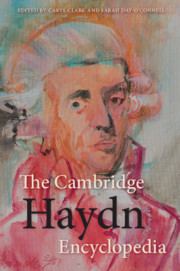Book contents
- The Cambridge Haydn Encyclopedia
- The Cambridge Haydn Encyclopedia
- Copyright page
- Dedication
- Contents
- Figures
- Music Examples
- Contributors
- Preface and Guide to Readers
- Acknowledgments
- Chronology
- Abbreviations
- List of Entries and Essays
- Dictionary
- Bibliography
- General Index
- Index of Compositions
- References
Bibliography
Published online by Cambridge University Press: 22 April 2019
- The Cambridge Haydn Encyclopedia
- The Cambridge Haydn Encyclopedia
- Copyright page
- Dedication
- Contents
- Figures
- Music Examples
- Contributors
- Preface and Guide to Readers
- Acknowledgments
- Chronology
- Abbreviations
- List of Entries and Essays
- Dictionary
- Bibliography
- General Index
- Index of Compositions
- References
- Type
- Chapter
- Information
- The Cambridge Haydn Encyclopedia , pp. 407 - 450Publisher: Cambridge University PressPrint publication year: 2019

